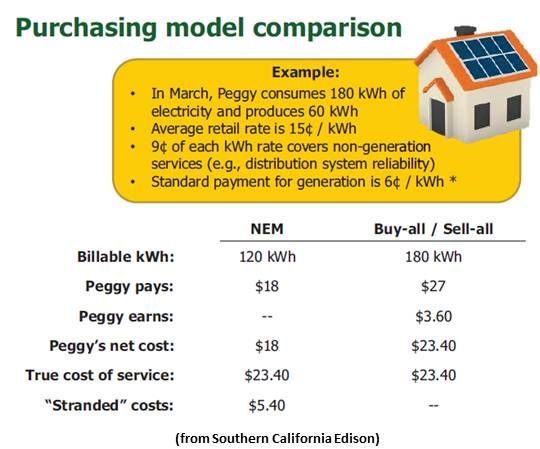NEM, the solar industry’s key incentive in California, benefits some 99 percent of the state’s solar owners. It allows them to roll their meters backward for every kilowatt-hour they send to the grid (up to the point where their bills zero out). The return they get on the electricity they generate is the same retail rate they pay for what they consume.
“Net metering is like the civil rights legislation for solar,” explained Solaria Vice President for External Relations and Vote Solar co-founder David Hochschild. “It ensures that the power you generate at your home, your business or your school that is fed back into the grid is valued at a rate equal to what you would pay the utility if you were buying power.”
But solar’s “backbone policy,” Hochschild said, will soon be almost the only thing left to drive solar growth. “The California Solar Initiative was structured when it was launched in 2007 as a ten-step incentive program, and we are now at step ten,” he said. “There is not another incentive program that will replace that.”
Net metering was instituted by California’s legislature in the mid-1990s. The initial 0.1 percent cap was set by the CPUC, which manages the IOUs’ monopolies, to balance the use of utility profits for the advancement of renewables with protecting utility shareholders. As demand for solar grew, the CPUC ratcheted the cap up.
“We are operating under a 5 percent cap today,” explained Mainstream Energy Director of Government Affairs Ben Higgins, but “the question has always existed as to whether the utilities were using the proper methodology to calculate the cap, [so] the solar industry filed a motion with the CPUC requesting that they take a look at this issue.”

On April 11, CPUC President Michael Peevey issued a finding that “the IOUs are calculating this net metering cap contrary to the plain language and intent of the law,” Higgins said.
Utilities want to use “utility peak demand” in the cap’s calculation, Higgins said, whereas the CPUC proposes to use “an aggregate of individual customer peak demand.” But these complexities are less important than the fundamental point that “the utilities are and have been calculating the cap incorrectly.”
The new proposal “gives roughly two additional gigawatts under the existing 5 percent cap,” Higgins said, and that “gives us significant additional time to aggregate the data, have a reasoned discussion, and hash out what net metering should look like in a post-5-percent environment.”
Though the CPUC will decide only how to define the cap, California’s IOUs have used the debate to question NEM.
An electricity bill’s per-kilowatt-hour charge, Higgins explained, has three primary portions, “the generation portion of the charge, the amount for that kilowatt-hour to actually be generated, the transmission portion of the charge, the part you pay for the use, construction, maintenance, etc., of the transmission line between the generation station and the local substation, and the distribution charge that is very similar to the transmission portion but is for the distribution system that actually allows the electricity to be delivered.”
“NEM customers avoid paying non-generation components of rates for the portion of their electricity consumption that is ‘netted out,’ even though they still use these services,” a PowerPoint presentation from Southern California Edison (SCE) explained, and “non-NEM customers pay for the portion of the non-generation services that NEM customers avoid.”
This is, SCE argued, “an inequitable transfer of cost burden from (often affluent) NEM program participants to non-NEM customers.”

Instead of NEM, SCE would like a “buy-all/sell-all (BA/SA) model” in which customers pay standard retail rates and get some payment for every kilowatt-hour they produce. BA/SA, however, would reimburse not the retail rate but only the generation portion of the retail rate.
SCE’s PowerPoint said this “recoups non-generation charges” from solar system owners “who still receive important grid services,” while it also “equitably allocates” and “transparently controls and manages costs.”
Solar advocates strongly disagree. “The utilities’ proposals grossly exaggerate the costs and completely ignore the benefits” of residential rooftop solar, Higgins said.
Hochschild cited a study on the cost-effectiveness of NEM in the Pacific Gas and Electric (PG&E) service territory by Crossborder Energy that concluded that, “on average over all customer classes, NEM does not impose costs on non-NEM customers,” adding, “on average, over all customer classes, NEM may now be cost-effective throughout the investor-owned utilities’ territories.”
“Cost in our electric infrastructure in California,” Hochschild explained, “is driven by peak demand.” There is, he said, “a huge benefit to reducing peak,” and that is what the residential rooftop solar supported by NEM does. “There are costs, but there are also benefits, and it works out that it is not really a subsidy.”
“The takeaway,” Higgins said, “is that there are two very different schools of thought about the costs and benefits of net metering.” The debate, he said, needs to be slowed. “We need time to make sure the decisions on net metering made in Sacramento and San Francisco are the right ones.”



